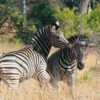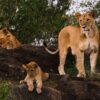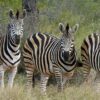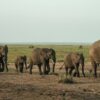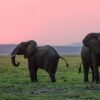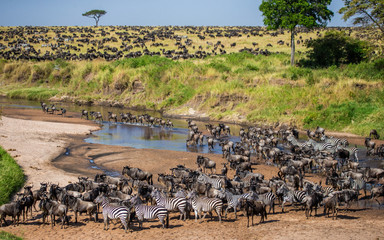10 Best National Parks for a Kenya and Tanzania Safari
Which are the best national parks for Kenya and Tanzania safari?
Planning a trip to East Africa brings up a classic debate: which is better, a safari in Kenya or Tanzania? The truth is, you can’t go wrong with either. Both countries host some of the best national parks in Africa, offering incredible wildlife and stunning landscapes. Instead of choosing one, why not explore the best of both? A combined 10-day Kenya and Tanzania safari allows you to experience the ultimate African adventure.
If you’re wondering how to book a safari in Tanzania or what the best safari in Kenya is, you’re in the right place. We’ve compiled a list of the top 10 national parks across both countries to help you build the perfect Tanzania safari itinerary or Kenya adventure. From vast plains to volcanic craters, these parks showcase the very best of East Africa.
1. Masai Mara National Reserve, Kenya
The Masai Mara is often considered the best safari park in Kenya, and for good reason. This iconic reserve is synonymous with classic African safaris. Its wide-open savannahs, dotted with acacia trees, are teeming with wildlife year-round. It is without a doubt one of the top 10 national parks in Kenya.
The Great Wildebeest Migration
The Mara is most famous for hosting the Great Wildebeest Migration from July to October. This is when over a million wildebeest, zebras, and gazelles thunder across the plains and make dramatic crossings of the Mara River. It’s a breathtaking spectacle of survival that places the Mara firmly among the best national parks in East Africa.
Big Cat Country
The Masai Mara has one of the highest lion densities in the world. You have an excellent chance of spotting lions, cheetahs, and elusive leopards. This makes it a top destination for those eager to see predators in action. This park easily tops the list of the top 10 game reserves in Kenya.
Pro Tip: For a unique perspective, take a hot air balloon safari at sunrise. Floating silently above the plains as wildlife begins its day is an unforgettable experience.
2. Amboseli National Park, Kenya
Amboseli National Park offers one of the most iconic sights in Africa: huge herds of elephants with the snow-capped peak of Mount Kilimanjaro in the background. Although the mountain is in Tanzania, Amboseli provides the best views.
Land of Giants
Amboseli is renowned for its large elephant herds. You can get incredibly close to these gentle giants as they roam freely across the dusty plains and marshlands. The park’s conservation efforts have allowed these elephant families to thrive for decades.
Birdwatcher’s Paradise
The park’s swamps and lakes attract a rich variety of birdlife, with over 400 species recorded. From pelicans and flamingos to raptors, Amboseli is a haven for bird enthusiasts, making it one of the best national parks in Kenya.
Pro Tip: For the clearest views of Mount Kilimanjaro, wake up early. The mountain is often shrouded in clouds by mid-morning, so sunrise offers your best photo opportunity.
3. Samburu National Reserve, Kenya
For a safari experience that’s off the beaten path, head to Samburu National Reserve. Located in the arid northern part of the country, its rugged landscape is a world away from the grassy plains of the Mara.
The “Special Five”
Samburu is home to a unique set of animals known as the “Special Five,” which are adapted to the dry conditions. These include the Grevy’s zebra, the reticulated giraffe, the Somali ostrich, the gerenuk, and the Beisa oryx. Spotting these rare creatures is a highlight of any visit.
A Unique Cultural Experience
The reserve is also home to the Samburu people, whose vibrant culture is closely tied to the land. Visiting a local village provides insight into their traditional way of life and deep connection with nature.
Pro Tip: Stay at a lodge along the Ewaso Ng’iro River. This is the lifeline of the reserve, and you can often watch elephants and other animals come to drink right from your accommodation.
4. Serengeti National Park, Tanzania
Crossing the border into Tanzania, Serengeti National Park is an absolute must-see. As one of the largest national parks in Africa, its name means “endless plains” in the Maasai language, and it lives up to the name. Many consider it one of the top 10 national parks in Africa.
The Heart of the Great Migration
The Serengeti is the other major stage for the Great Wildebeest Migration. Depending on the time of year, you can witness different phases of this incredible journey, from the dramatic river crossings in the north to the calving season in the south.
Unmatched Wildlife Viewing
The sheer volume of wildlife here is astounding. The Serengeti delivers incredible sightings of the Big Five and is particularly famous for its healthy lion and cheetah populations. Its vastness ensures that you can find secluded spots even during peak season. You can find many discussions on the best safari in Tanzania Reddit threads that rave about the Serengeti.
Pro Tip: If your Tanzania safari and Zanzibar packages allow, consider staying in a mobile camp. These camps move with the migration, placing you right in the heart of the action no matter when you visit.
5. Ngorongoro Crater, Tanzania
A short drive from the Serengeti lies the Ngorongoro Crater, one of Africa’s most remarkable natural wonders. This massive volcanic caldera is a self-contained ecosystem, often called “Africa’s Garden of Eden.” This is easily one of the top 10 places to visit in Tanzania.
A Natural Wonder
The crater floor is a haven for wildlife. It contains one of the highest concentrations of animals on the continent, including a resident population of the endangered black rhino. You have a fantastic chance of seeing the Big Five in a single day.
Breathtaking Scenery
The view from the crater rim is simply breathtaking. As you descend 600 meters to the crater floor, you pass through lush forests before the landscape opens up into a vast plain filled with wildlife.
Pro Tip: The crater floor can get busy. Start your game drive as early as possible to enjoy the scenery and wildlife with fewer vehicles around.
6. Tarangire National Park, Tanzania
Often overlooked in favor of its more famous neighbors, Tarangire National Park is a hidden gem. It offers a fantastic safari experience, especially during the dry season.
The Land of Baobabs and Elephants
Tarangire is famous for its majestic baobab trees, which create a stunning, ancient landscape. It is also home to one of the largest elephant concentrations in Tanzania. During the dry season (June to October), the Tarangire River becomes a magnet for wildlife.
Excellent Birding
With over 550 bird species, Tarangire is a paradise for birdwatchers. The park’s diverse habitats, from swamps to woodlands, support a wide array of resident and migratory birds.
Pro Tip: Consider a walking safari with an armed ranger. It offers a thrilling and intimate way to experience the bush and learn about the smaller details you might miss from a vehicle.
7. Lake Manyara National Park, Tanzania
Although smaller than other national parks in Tanzania, Lake Manyara offers a diverse range of habitats and unique wildlife sightings.
Tree-Climbing Lions
Lake Manyara is one of the few places in Africa where you can see lions lounging in the branches of acacia trees. While not guaranteed, spotting these felines is a truly special experience.
Flamingo Flocks
The alkaline lake is a seasonal home to large flocks of pink flamingos, creating a vibrant spectacle against the backdrop of the Rift Valley escarpment. The park is also known for its large troops of baboons.
Pro Tip: Combine your game drive with a Treetop Walkway experience. This canopy walk offers a unique perspective of the forest and its inhabitants.
8. Ruaha National Park, Tanzania
For those seeking a more remote and wild safari, Ruaha National Park is an excellent choice. It’s Tanzania’s largest national park but receives far fewer visitors than the northern circuit parks.
Untouched Wilderness
Ruaha offers a true sense of adventure. Its rugged and remote landscape is home to large prides of lions, cheetahs, and one of East Africa’s largest populations of wild dogs. The park’s isolation means you often have sightings all to yourself.
Walking and Fly Camping
This park is a great destination for walking safaris and fly camping. These activities allow for an immersive bush experience, connecting you directly with the sights, sounds, and smells of the African wilderness.
Pro Tip: Visit during the dry season (June to October) when the Great Ruaha River shrinks, concentrating wildlife along its banks and making for exceptional game viewing.
9. Tsavo East & Tsavo West National Parks, Kenya
Together, Tsavo East and Tsavo West form the top 10 largest National Park in Kenya and one of the largest conservation areas in the world. Their vast, wild landscapes offer a different kind of safari experience.
The “Red Elephants” of Tsavo
The parks are famous for their “red elephants,” which get their color from rolling in the region’s distinctive red dust. Seeing these crimson giants is a memorable sight.
Lava Flows and Springs
Tsavo West is known for its dramatic volcanic scenery, including the Shetani Lava Flows. A visit to Mzima Springs is a must, where you can see hippos and crocodiles through an underwater viewing chamber.
Pro Tip: Given the parks’ immense size, allow at least two days for each to explore properly. Tsavo East is flatter and more open, while Tsavo West is more hilly and scenic.
10. Lake Nakuru National Park, Kenya
Famous for its incredible birdlife, Lake Nakuru National Park is a compact and beautiful park that is ideal for a day trip or a short stay. It is consistently ranked among the top 20 national parks in Africa.
Rhino Sanctuary
Lake Nakuru is one of Kenya’s most successful rhino sanctuaries, providing a safe haven for both black and white rhinos. Your chances of spotting them here are very high.
A Spectacle of Pink
While flamingo numbers have fluctuated in recent years, the lake can still host thousands of these birds, creating a stunning pink hue along the shoreline. It remains a key destination on any list of national parks in Kenya.
Pro Tip: Drive up to Baboon Cliff for a stunning panoramic view of the lake and the surrounding park. It’s a great spot for photos, especially in the late afternoon.
So, when it comes to the best safari Kenya or Tanzania, the answer is both. Each park offers a unique window into the magic of Africa. Hopefully, this guide helps you decide which is the best national park for Kenya and Tanzania safari 2022 and beyond. If you’re looking for a visual aid, a national parks in Eastern Africa map can help you plan your route. You can even combine your adventure with a trip to the coast by booking safari Tanzania Zanzibar packages.
Frequently Asked Questions
You’ve got questions, and we’ve got answers. We’re diving into the most common queries to help you decide which East African giant is the right fit for your dream safari adventure.
Which safari is better, Tanzania or Kenya?
This is the ultimate safari showdown, but there’s no single winner. The “better” safari depends entirely on what you’re looking for.
Kenya often offers a more budget-friendly experience with a highly developed tourism infrastructure. It’s home to the world-famous Masai Mara and offers a huge variety of parks, from the elephant-filled plains of Amboseli to the rugged landscapes of Samburu. It’s fantastic for first-time safari-goers and those on a tighter schedule.
Tanzania, on the other hand, is known for its vast, wild spaces like the Serengeti and the unique Ngorongoro Crater. Safaris here tend to be more expensive, partly because the national park fees are higher and the parks themselves are larger, requiring more travel time. Tanzania offers a sense of immense scale and remoteness that’s hard to match.
What national park is between Kenya and Tanzania?
There isn’t a single national park that straddles the border as a jointly managed entity. However, the Masai Mara National Reserve in Kenya and Serengeti National Park in Tanzania are part of the same ecosystem. The border between the two countries runs right through this massive wilderness area. Animals, especially during the Great Migration, move freely between them, following the rains and fresh grazing lands, completely unaware of human-drawn lines on a map.
Does Kenya or Tanzania have better beaches?
While both countries have beautiful coastlines along the Indian Ocean, Tanzania is generally considered the winner for beaches. The Zanzibar archipelago, just off the coast of Tanzania, is world-renowned for its stunning white-sand beaches, turquoise waters, and rich history. Islands like Pemba and Mafia also offer incredible snorkeling, diving, and a more secluded island experience.
Kenya’s coast is also lovely, with popular destinations like Diani Beach, which has been voted one of Africa’s best beaches. However, for sheer variety and iconic island paradise appeal, Zanzibar gives Tanzania the edge.
Is Masai Mara better or Tanzania as the best national parks in Africa?
This question is a bit like asking if a single star is better than a galaxy. The Masai Mara is a single (though spectacular) reserve in Kenya, while Tanzania is a large country with multiple world-class parks.
The Masai Mara offers an incredibly concentrated wildlife experience. It’s known for its high density of predators and for hosting the dramatic river crossings of the Great Migration. It’s an exceptional destination.
However, Tanzania’s northern safari circuit includes the Serengeti, Ngorongoro Crater, Tarangire, and Lake Manyara. The Serengeti alone is about ten times the size of the Mara, offering a greater sense of scale and variety in landscapes. So, while the Mara is phenomenal, it’s just one part of Kenya, whereas Tanzania offers a multi-park safari circuit that is legendary in its own right.
Why is a Tanzania safari more expensive than a Kenya?
Several factors contribute to the higher cost of a Tanzanian safari. First, national park fees in Tanzania are significantly higher for international visitors compared to Kenya. Second, the sheer size of parks like the Serengeti means longer driving distances between locations, which increases fuel and vehicle costs. Finally, many of Tanzania’s lodges and camps are in more remote, exclusive locations, which adds to the operational costs and, therefore, the price you pay. Kenya’s more compact safari circuit and developed infrastructure help keep costs down.
Which African country is best for a safari?
This is a tough question, as “best” is subjective. Besides Kenya and Tanzania, other incredible safari destinations include:
- South Africa: Known for Kruger National Park, excellent infrastructure, and the ease of self-drive safaris. It’s also great for combining a safari with city life in Cape Town.
- Botswana: Offers exclusive, high-end safaris in the unique Okavango Delta and Chobe National Park, famous for its massive elephant herds. It focuses on low-impact, high-cost tourism.
- Namibia: Offers a completely different experience with its stark desert landscapes, towering sand dunes, and desert-adapted wildlife.
- Zambia: Famous for being the birthplace of the walking safari, offering an intimate and thrilling way to experience the bush.
For a classic, wildlife-rich East African experience, Kenya and Tanzania remain top contenders.
Which month is best for safari in Kenya and Tanzania?
The best time to visit is generally during the long dry season, from June to October. During these months, vegetation is thinner, and animals congregate around rivers and waterholes, making them easier to spot. This period also coincides with the Great Migration’s river crossings in the Masai Mara (typically July-September) and peak wildlife viewing in the Serengeti.
A shorter dry season from January to February is also an excellent time, especially in Tanzania, as it’s the calving season for the wildebeest in the southern Serengeti.
Is a safari in Tanzania worth it?
Absolutely. While it may be more expensive, a Tanzanian safari offers an unparalleled sense of scale and wilderness. Witnessing the endless plains of the Serengeti, descending into the Ngorongoro Crater, and seeing the sheer volume of wildlife is an experience that is worth every penny. The feeling of being in such a vast, untouched ecosystem is something that will stay with you forever.
Is Kenya or Tanzania better for safari in December?
December is a great month for a safari in both countries, as it falls within the “short rains” period, but the rain is usually in the form of afternoon showers that don’t disrupt activities.
In Kenya, the landscape is lush and green, and it’s a great time for birdwatching as migratory birds arrive. Wildlife is abundant.
In Tanzania, December marks the beginning of the calving season in the southern Serengeti, as the wildebeest herds gather to give birth. This attracts a lot of predator action, making it a very exciting time to visit.
Overall, Tanzania might have a slight edge in December due to the start of the calving season, but both countries offer a fantastic holiday safari experience.
Which safari is better, Kruger or Serengeti?
This is another classic safari debate. Both are massive, world-class wildlife destinations.
The Serengeti is famous for its vast, open plains and the Great Migration. The landscape feels endless, and the sheer number of animals is staggering. It offers that quintessential “Out of Africa” feeling.
Kruger National Park in South Africa has a more varied landscape with denser bushveld. It has an excellent road network, making self-drive safaris a popular and affordable option. Kruger is also renowned for its reliable Big Five sightings, especially leopards and rhinos, which can be more elusive in the Serengeti.
Ultimately, the Serengeti offers scale and natural drama, while Kruger provides accessibility and incredible biodiversity in a different type of landscape.
Ready for an unforgettable adventure?
Your Kenya and Tanzania safari is just a click away!
Let the experts at Thrill Bound Adventures handle all the details so you can focus on making memories. From thrilling game drives to custom-tailored Kenyan expeditions, we bring your dream trip to life.
Contact Thrill Bound Adventures today to book your next adventure!
Contact
- Mobile: +254 713 915 070
- Hotline: +254 713 915 070
- thrillboundadventuresltd@gmail.com
- info@thrillboundadventures.com


